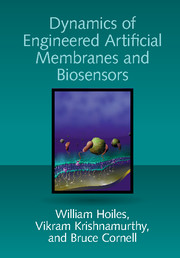Book contents
- Frontmatter
- Contents
- Preface
- List of Abbreviations
- Part I Introduction and Background
- Part II Building Engineered Membranes, Devices, and Experimental Results
- Part III Dynamic Models for Artificial Membranes: From Atoms to Device
- 8 Reaction-Rate-Constrained Models for Engineered Membranes
- 9 Reaction-Rate-Constrained Models for the ICS Biosensor
- 10 Diffusion-Constrained Continuum Models of Engineered Membranes
- 11 Electroporation Models in Engineered Artificial Membranes
- 12 Electroporation Measurements in Engineered Membranes
- 13 Electrophysiological Response of Ion Channels and Cells
- 14 Coarse-Grained Molecular Dynamics
- 15 All-Atom Molecular Dynamics Simulation Models
- 16 Closing Summary for Part III: From Atoms to Device
- Appendices
- Bibliography
- Index
10 - Diffusion-Constrained Continuum Models of Engineered Membranes
from Part III - Dynamic Models for Artificial Membranes: From Atoms to Device
Published online by Cambridge University Press: 25 May 2018
- Frontmatter
- Contents
- Preface
- List of Abbreviations
- Part I Introduction and Background
- Part II Building Engineered Membranes, Devices, and Experimental Results
- Part III Dynamic Models for Artificial Membranes: From Atoms to Device
- 8 Reaction-Rate-Constrained Models for Engineered Membranes
- 9 Reaction-Rate-Constrained Models for the ICS Biosensor
- 10 Diffusion-Constrained Continuum Models of Engineered Membranes
- 11 Electroporation Models in Engineered Artificial Membranes
- 12 Electroporation Measurements in Engineered Membranes
- 13 Electrophysiological Response of Ion Channels and Cells
- 14 Coarse-Grained Molecular Dynamics
- 15 All-Atom Molecular Dynamics Simulation Models
- 16 Closing Summary for Part III: From Atoms to Device
- Appendices
- Bibliography
- Index
Summary
Introduction
In this chapter (and the following three chapters) we study mesoscopic mathematical models for the dynamics of engineered membranes. This chapter constructs mesoscopic models for the following two synthetic biological devices built out of artificial membranes:
(i) the ion-channel switch (ICS) biosensor and
(ii) the pore formation measurement platform (PFMP).
Mesoscopic models deal with physical phenomena at the micrometer length scale and millisecond time scale – their level of abstraction lies between the macroscopic reactionrate models and the microscopic atomistic models. To put this chapter into perspective, recall that Chapter 4 dealt with the construction of engineered membrane devices. Also, Chapters 8 and 9 constructed macroscopic reaction-rate models of these devices which comprised ordinary and fractional-order differential equations. At the end of this chapter we illustrate how approximations of the continuum models can be used to construct the parameters of the macroscopic models in Chapters 8 and 9.
As discussed in Chapter 9 the ICS biosensor operates in either the mass-transportinfluenced kinetics or the reaction-rate-limited kinetics regime. A schematic of the ICS biosensor and PFMP in the flow chamber is provided in Figure 10.1. If the analyte concentration and/or fluid flow velocity is sufficiently large, the advection-diffusion dynamics of the analyte can be neglected and only the macroscopic surface reaction dynamics govern the impedance response of the ICS and PFMP. These reaction-rate-limited kinetics models were the focus of Chapter 9. In this chapter we consider the masstransport- influenced kinetics regime, where the advection-diffusion dynamics cannot be neglected in the fluid flow chamber. Therefore, the dynamic mesoscopic models involve diffusion-type partial differential equations (PDEs) with boundary conditions determined by reaction-rate-type ordinary differential equations (ODEs).
Figure 10.1 illustrates the mesoscopic model which couples the electrolyte dynamics with the surface reactions. The electrolyte dynamics involve the advection-diffusion of molecules and ions, and may also include electrodiffusion effects if the molecules and ions are charged. The study of the electrodiffusion of charged particles such as molecules and ions in the presence of an applied external electric field is of great importance in a number of disciplines. For example, in semiconductors these mesoscopic models describe the dynamics of electrons and holes and are used for the design of modern electronic components such as transistors, diodes, and infrared lasers [80].
Information
- Type
- Chapter
- Information
- Dynamics of Engineered Artificial Membranes and Biosensors , pp. 174 - 211Publisher: Cambridge University PressPrint publication year: 2018
